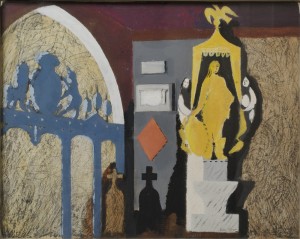Portrait of Anne Leighton - jewellery detail c1620

Hidden Content, Images, Videos and Documents
Anne Leighton (c1591– 1628), first wife of Sir John St.John of Lydiard Park and daughter in law of Lucy Hungerford, wears a flower embroidered costume spangled with jewels in a portrait you can see in the Dining Room at Lydiard House.
Anne’s hair is swept back in the manner reminiscent of Queen Elizabeth I and decorated with a pendant in front and with a jewelled ‘halo wreath’. By comparing the portraits of Anne and her mother in law, Lucy (see above), we can see how fashions have changed in a generation. Gone are the statement pieces and any extravagant display of wealth is confined to Anne's elaborately embroidered and beaded dress, together with her hair ornaments.
Anne also wears a simple pearl necklace which was often considered to be sufficient. It is just visible above her costly ruff which is made of three layers of lace. Her ‘halo wreath’, an elaborate addition, is decorated with diamonds and pearls.
The ornament in Anne's hair and her earrings reflect the change in fashion for more geometric designs. The pendant in her hair appears to be made of pearls, diamonds, rubies and sapphires, but overall, she wears fewer ornaments than Lucy.
There was a delight in the colour and sparkle of jewels in the 17th century, especially as they became more easily available, but at the same time there was still a belief in the medicinal virtues of certain gems, those effective against poison being especially valued. Books or lapidaries were still being written about their benefits. It was thought that diamonds might repel poison and even endow the wearer with constancy and serenity. The author of one such lapidary, Andrea Baccio, believed that wearing gems for their ‘purity, translucence, and beauty may induce men to lead lives of similarly unsullied purity’. This might explain why coloured stones such as sapphires, rubies and emeralds were favoured, especially by women who were expected to be constant and pure.
In the monument her husband erected for himself and his two wives in St Mary’s church , Sir John extols Anne as being ‘endowed with noble gifts of mind, body, and manner, a rare example of virtue and piety’.
- Year:
- c. 1620
- Type:
- Portrait
- Location:
- Dining Room, Lydiard House
- Owner:
- Swindon Borough Council
- Copyright:
- Friends of Lydiard Park
- Credit:
- Pete Melsom
- Last updated on:
- Wednesday 6th September 2023



